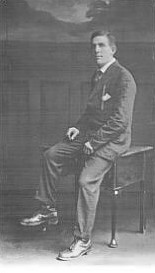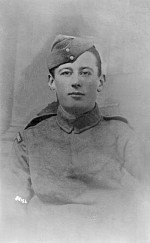
HEDGER FAMILY STORIES
|
|
Harry Hedger (Sr.) |
| When he was young, Harry worked as an
agricultural labourer and carter, apparently moving around to where the
work was. He married Clara Fish in 1884, when they were both living in
Henfield, West Sussex, and where his eldest daughter, Emily, was born.
His other children were born in various nearby villages, and by about
1900 the family were back in Henfield. His daughters Annie, Alice and Kate married and settled in Sussex, but Harry and Clara, with their other three daughters Emily, Enid and Ivy, went to London - probably in the early 1920s, and probably to look for more secure, regular work. They lived in various roads in East Dulwich, South London, and finally settled in St. Aidan's Road. Enid married and moved to West Wickham, but when Ivy and Emily both married they and their families all lived in St. Aidan's Road (Harry and Clara lived in the same house as Ivy). Later on, Harry's son, Harry and his family came to London and also settled in the same road. Harry Sr. got a job in Camberwell Old Cemetery as a gravedigger and gardener, where he worked until he retired at the age of about 84. He then got a job as a part-time gardener to Mr. Page, who owned the confectionery factory at the end of the road. Mr. Page once had to tell Harry to get down from a tree Harry had climbed to cut down some branches, because he was concerned for his safety, but Harry told him to mind his own business! If he wanted to do something he'd do it, but if he didn't want to do it, he wouldn't! He stopped work altogether when he was about 90, and died (of old age!) at the age of 94. He was tall and slim, and very stubborn and independent. When he retired he used to have a pint of beer every day in his local pub, The Herne Tavern, but would never let anyone buy him another pint. |
|

|
Harry Hedger (Jr.) |
| Harry was born in Edburton, Sussex, and went
to Small Dole School when he was about eight years old, with some of his
sisters and cousins from his mother's side (Fish family). Here, he
became best friends with George Barber, and they remained friends
throughout their lives. When he was young he did some farm work, but some time before WW1 he went to America - first to New York where he worked as a chauffeur. He also went to Louisiana, here working as a foreman in a factory which manufactured suit-cases. He went on a cattle-drive to Canada, and was there when WW1 broke out. He returned to England to join the army, and was sent to France. He was in the artillery, where the guns were drawn by horses. At the end of the war he got a job in Leicestershire as a driver for the Co-Op (Co-operative Movement). Here he met and married Elizabeth Armstrong. Their first three children were born in Leicestershire, and in about 1925 Harry went to London (probably for work), his parents already being there. He, like his father, got a job in Camberwell Old Cemetery as a gravedigger/gardener, and later on became a foreman. (This tradition was carried on by his son, Lewis, who was also at various times a stone mason, gravedigger, gardener, crematorium operator, and eventually became Superintendent of Southwark's cemeteries and crematorium. As such, he lived in the lodge house at the Old Cemetery.) The rest of the family came down from Leicestershire, and lived in several roads in East Dulwich, finally settling at 28 St. Aidan's Road. Harry's great hobby was gardening, and the little garden at the back of their house was always filled with flowers. During WW2 he joined the Camberwell branch of the Home Guard (Dad's Army) and did fire-watching at the cemetery (watching for incendiary bombs to extinguish them quickly). When his wife Elizabeth (whom he called "Edge") died in 1972, he went to live with his daughter, May, and her husband in Mundania Road, East Dulwich. Despite going through two world wars, and smoking all his life, he died at the age of 85. |
|
|
Mark Hedger |
 |
|
He did work in many fields. When he finished school he won a scholarship to a Church of England seminary to become a minister. Unfortunately, because his father could not afford to help him pay for his supplies and clothing he could not go. He was a leather makers apprentice. In 1916 he was in the Army. At first he went in doing work for the cavalry. This included working on the saddles and bridles. They then stopped using the horses, and
he was transferred to the Royal Flying Corp., where he worked on the planes. After the war jobs were hard to find. He worked odd jobs such as digging roads, as a houseman, waiter, painter, and repaired boots making about 12 pounds a week. During the war he was made to sleep in a tent on the snow covered ground. He developed a cough and a spot was found on his lung. After operating it was found to be a mucus cyst. Later in life this was where
cancer set in. In 1920 he became a roundsman for a dairy and later in 1928 the manager. In about 1951 he had his own dairy business. In the mid 1950's he developed back problems with slipped discs. He and Queenie consequently got a house with their daughter
Phyllis, and son-in-law, Frederick. The house was split into two flats (apartments). Before his death in 1965 he developed cancer in his lung. It was successfully treated with radiation. But, the radiation weakened him and he eventually died of pneumonia. The family has a small bible presented to Mark Hedger by the Worthing Baptist Sunday School, just before leaving for the war in 1917. He was 18 years old. He stood a good 6ft tall. There is a bench dedicated to Mark located at the Windsor and Eton Cricket Club. The Mayor was in attendance at the dedication. |
|
|
|
Allan Hedger |
| Was a Farm Bailiff in charge of cows on a farm. They were all country folk. Of three of his sisters, we know two were very tall as he was. The other was short and plump. | |
|
Please check back for more stories as we will keep adding them. |
|